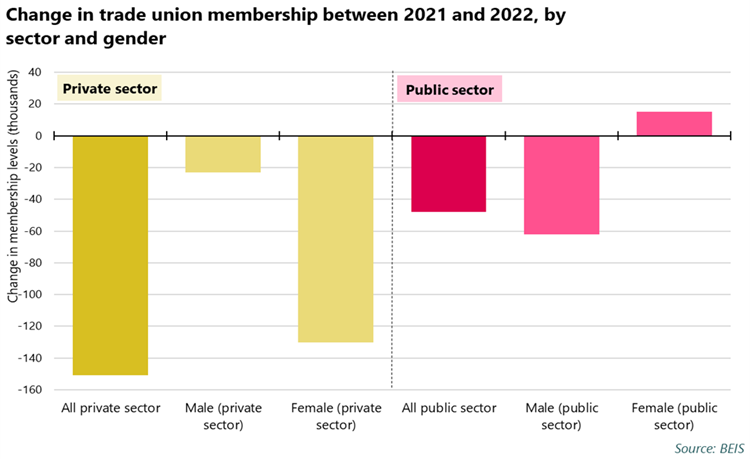Three charts on trade union membership
Chart 1 – Membership and density has fallen for two consecutive years.

Between 2017 and 2020, trade union membership and membership density were in steady state. Both increased for three consecutive years. However, we have now had two years of decline and that is a concern. In the last two years alone, we have lost over a quarter of a million members.
Despite membership and density increasing during that period, membership got nowhere near where it was in 2000 (the highest it’s been since 1995) and density in the private sector fell in most of those years.
As it stands, overall density is just 22% - a figure worryingly close to just 1 in 5 workers carrying a union card. The situation is worse in the private sector, where just 12% of workers are in a union. Amongst women, just 1 in 10 working in the private sector are in a union.
Chart 2 - We face massive challenges in the private sector. And in the public sector density is below 50 per cent for the first time.

The big news – for me anyway – in the latest set of union membership figures is that density in what was the trade union stronghold of the public sector has now fallen below 50%. It is now 48.6%.
This statistic alone should be a massive call to action to the movement.
We’ve been a (small) minority movement in the private sector for generations and there are reasons for that – restricted access to workplaces, limited collective bargaining, the growth of insecure work and small workplaces etc to name just a few - many of which are beyond the immediate control of unions. But in the public sector where collective bargaining coverage is greater, we have more reps and facility time agreements and of course where the tradition of unions being a part of the workplace is more entrenched, we have no excuse to let this decline continue.
The situation for us in the private sector is so bad that it is really quite difficult to think of a response that matches the scale of the challenge that we face.
Chart 3 - We need to organise to scale.

The only statistics available on union attempts to win new recognition agreements are published in the Central Arbitration Committee (CAC) Annual Reports. These reports provide the average size of a bargaining unit – that is the average number of members that unions are trying to get recognition for.
Now, I accept that many unions don’t go anywhere near the statutory process when trying to get recognition. Whilst it's better than nothing, it's cumbersome and tilted in favour of employers, who may actively try to discourage employees from joining a union and supporting recognition. But we are where we are.
The CAC stats tell us that as a movement we aren’t anywhere near close to organising to the scale we need to if we are going to stop the decline reflected in the latest stats, let alone reverse it and start to grow.
For example, if we take 2018/19 – the best year in the last 10 for the size of a barging unit (250 workers) – and consider that the number of non-members in the private sector is approximately 17.5 million - then you appreciate why finding ways to organise to scale must be a movement priority.
Where does this leave us?
They say the first step to solving a problem is accepting that there is one. And fortunately, there are very few people in the movement who are either unaware of or who would deny the size of the task we face. The debate is around what do we do.
The TUC’s role in addressing this task is not to recruit workers into unions, that’s the job of our affiliates. What we can do is hold a mirror up to the movement, encourage and support unions in coordinating organising activity and providing training and other support to reps, activists, officers and organisers. We can also provide spaces for unions to come together to collaborate and develop innovative approaches to organising.
Although this blog has painted a bleak picture, I’m not suggesting that the movement isn’t doing anything to address these challenges, or that the decline in membership is the fault of unions. We all know that there are many reasons related to the wider political and economic environment that impact on trade union membership and our ability to organise.
And we know that unions are organising and winning recognition and taking on some big international corporations in the process. The challenge is to make the good practice into common practice and then scale it up massively.
To end this particular blog on a positive note and show that union revival is the art of the possible here’s some of recent examples of workers coming together and winning recognition for their unions recorded by the TUC Solidarity Hub. And they’re all in the private sector!
Stay Updated
Want to hear about our latest news and blogs?
Sign up now to get it straight to your inbox
